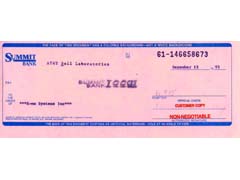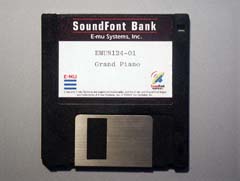SoundFont® Trademark
The VCOS MIDI synthesizer grew out of my hobby for software synthesis.
- 1977-1980 - PDP-8 Music
- PDP-8 Music was a 4-voice software synthesizer program written by John Spies that used an AM radio as a transducer.
At the Computer Science Research Lab of Northwestern University, we added DAC output and 8 waveforms selectable from the front panel.
I added ADSR and pitch envelopes via bank switching to pre-computed wave forms as real-time multiplies were too expensive in CPU time.
This work was with Bill Nowicki.
- 1986 - Yamaha DX-7 FM MIDI Synthesizer
- This was the first of many MIDI synths that I bought.
- 1987-1991 - Music4C
- M4C was a software synthesizer descended from the Max Mathews / Bell Labs "Music" tradition.
I used M4C in classes and grad work with Dr. James Beauchamp at U. of Illinois, Urbana-Champaign (UIUC).
- 1992-1994 - Roland S-550 disk tools
- The S-550 was a 12-bit sampler, a major advancement in those days over the 8-bit Ensoniq samplers.
I wrote some disk tools that were the start of using the Roland sound banks for software synthesis
- see the Sgroup Archive
for S-550 tools.
- 1992-1994 - CMuse
- CMuse was my real-time software synthesizer in C++ running on an Commodore Amiga 2000.
The original voices were based on M4C, with MIDI file format for input.
Sample playback was added using S-550 banks, and CMuse developed into the reference model for the VCOS MIDI Synthesizer.
- 1993-1994 - VCOS MIDI Synthesizer
- CMuse was hand translated AT&T DSP3210 assembly language, with 6-point interpolation for sample playback.
Typical processor allocation allowed for about 11 voices, but this could be doubled by allocating more of the DSP to the MIDI synthesizer.
The VCOS MIDI Synthesizer shipped with the AT&T Telephony PCs.

1993 - For the VCOS MIDI synthesizer, we contracted with E-Mu Systems for
the sound library.
The sound library was in Proteus(TM) form with assembly language tags for address references.
I wrote a program to convert it into a downloadable form based on my experience
with the Roland S-550.
This also provided prototype SoundFont® function.
An expanded version of this library was later used
as the default SoundFont® bank for the Creative Labs Soundblaster 16 AWE. Here's
an image of the certified check (receipt copy) for $1 that I sent to E-Mu Systems so that
the trademark application could be submitted. Click on the image for
a larger version.

Here's an image of what I bought with the check - the first purchased SoundFont(TM)
Bank.
NoBell Home - gjm
- last update 1/17/2004, created 1/17/2004

